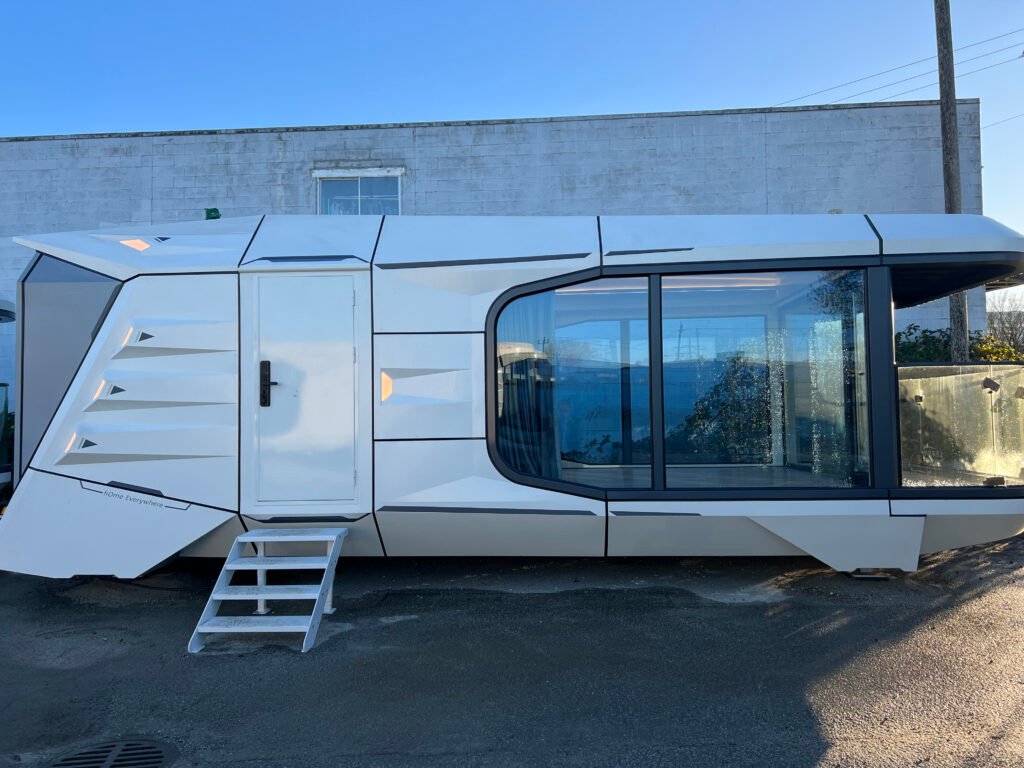Money and housing always go hand in hand. Buying land, building a home, or even setting up a small capsule house needs a solid financial plan. And if you don’t plan the finance side properly, financial stress breaks your back. Figuring out “how to finance a capsule house in Australia” is not as simple as walking into a bank and asking for a loan. Because Australia’s rules on building classes, permits and loan types are kinda tricky for you to figure out.
You can finance a capsule house in Australia through a construction loan (if it’s on owned land with a foundation), a home equity loan (if it’s a secondary dwelling), a commercial loan (for short-term rental or park use), or a personal/caravan-style loan (if it’s movable on leased land). The type of loan you get depends on where you place the house and how it’s classified under the National Construction Code.
That’s the quick overview. But I’ve got a lot more to share from my research on the latest Australian lenders, regulations and case studies. Let’s go step by step through the financing options, what banks look for, the costs involved and how to increase your approval chances.

Choose your path in Australia
Financing depends a lot on how and where you place the capsule house. I break it into common scenarios. Pick the one that sounds like your situation and see the financing route:
➔ Owned land with permanent foundation: You have a block of land and will bolt or build your capsule house on a foundation. In this case, you’re in the same category as a standard home build. You can apply for a construction loan with progress payments. Let me explain clearly: you’ll draw down money in stages (slab, frame, lockup, fitout, etc) as work is done. and then get a regular mortgage. You only pay interest on the drawn amount while building, which keeps early payments lower. Once the build is finished, the loan automatically converts to a standard home mortgage. Because the house is fixed and fully approved (NCC Class 1a), banks consider this a normal, permanent house. This path is common and well-supported by lenders.
➔ Tourism park or multi-unit (short stay): If you plan to site your capsule house in a holiday park or as multiple rental units, it’s typically classified as short-term lodging. The NCC treats these as Class 1b (boarding/guest house) because of temporary occupancy. Many lenders see Class 1b buildings as commercial property. In reality, that often means you need a commercial loan or special finance (sometimes called “equipment finance”) rather than a standard home loan. I recommend talking to lenders that offer business or commercial loans for tourism projects because a normal home loan usually won’t cover it.
➔ Movable unit on leased land or in a caravan park: If you’re parking your capsule on leased land (like in a caravan park) or towing it around, you don’t own the land. In this case, lenders may treat it like a caravan or RV. You can finance it usually through a personal loan or a caravan/RV loan. For example: Specialists like ANZ offer personal loans up to $75,000 to buy a caravan. Always do check on local rules because some states limit how long you can live in a movable home. But financing it as a vehicle (personal loan) is a common route.
➔ Secondary dwelling on an existing home: If you want the capsule house as a granny flat or studio in your backyard, you already have a home. Banks often let you borrow against your home’s equity. I learned that lenders may cover up to 100% of the build cost by using the equity in your main house. This might be a bigger mortgage or a home equity loan/line of credit. Basically, you use your existing home as security and the capsule becomes a second dwelling. This is similar to how granny flats are funded; as CommBank explains, you can borrow the entire build cost if you have enough equity.
Each scenario has its own loan type. I hope this helps you see which fits your plan. No matter the path, you must meet the lender’s criteria and get the right approvals.

What Australian lenders check
Lenders are careful about these builds. They look for proof of approval and realistic costs. In my research, I found these common checks:
- Approvals and classification: Banks want to see official planning and building approvals. You’ll need council or state permits showing your capsule house is allowed. Importantly, lenders check the NCC building class. A capsule on land should ideally be Class 1a (a normal single home). If it’s Class 1b (short-stay), lenders treat it as commercial. Make sure your plans clearly show the right classification. Also get engineering-certified plans. Without approved plans and classification, you can’t draw a building loan.
- Building contract and schedule: Lenders expect a fixed price building contract with a clear stage-by-stage drawdown schedule. For example: you can see on NAB’s site that they require a signed fixed-price contract before funding. The contract should break the work into stages (slab, frame, etc.) with costs for each. The lender’s valuer will inspect each stage before you draw those funds. At each drawdown, your builder must issue an invoice or claim certificate and you sign it to confirm work is done.
- Builder’s licence, insurance, compliance: Your builder must be properly licensed (or a registered owner-builder in some cases). As most banks insist on a licensed builder for construction loans. You’ll need builder’s warranty insurance (domestic building insurance) and public liability insurance in place before the first draw. The lender will ask for copies of those insurance policies up front. After construction, you’ll also need compliance certificates and an occupation certificate to prove the build meets regulations. Having these ready speeds up your loan.
By meeting these conditions, you show the bank that the project is legit. In short, get your permits, use a fixed contract and have a licensed builder with insurance. Then lenders will move forward with your loan.
Terms and costs in Australia
Building finance has extra costs beyond a normal mortgage. Here’s what to expect:
- Interest and drawdown fees: While building, loans are usually interest-only. That means during construction you only pay interest on the money drawn so far. This keeps repayments low until you move in. The lender only charges interest on each progressive draw. For example, if your loan is $200K but you’ve only drawn $50K for the slab, you pay interest on $50K. After finishing, the loan converts to principal-and-interest and you start paying down the loan balance. Note that some banks charge a fee each time you request a draw. Also expect valuation fees: a bank valuer will inspect the construction at each stage or at least at key stages. Legal fees apply when the loan is set up. All these costs add a few thousand dollars on top of your build.
- Soft costs (permits, utilities, site works): Beyond the builder’s price, there are “soft” costs. You always have to remember: plan for council and building permits, utility connection fees, delivery/installation of the capsule, trenching or foundation work, driveways, etc. These are usually paid out of pocket (not covered by the construction draw). For example: if you need to run new electricity and water lines, or level the site, add those costs in your budget. These extras can be significant. Unlike a standard home on flat land, moving a capsule may need extra site prep. Build them into your finance plan as upfront cash or added loan amount.
- LMI and timing: Lenders Mortgage Insurance (LMI) may apply if you borrow more than ~80% of the property value (land plus build). Since capsule homes might be valued lower by banks, your deposit/equity ratio is important. If you rely heavily on equity in your home (granny flat case), you might avoid LMI but check with the lender. Settlement timing is also key: construction loans in Australia pay builders directly at each stage. You don’t get all the money to your account instead the bank pays the builder after inspection. Final settlement (activating the home loan) happens when the build is finished and passes the final inspection. You also expect from the lender to do a last check (a final valuation/inspection) before the last payment.

Improve approval odds in Australia
To get your loan approved smoothly, follow these tips I gathered:
- Aim for Class 1a on owned land: If possible, place your capsule on owned land and attach it permanently (Class 1a). This makes it similar to a regular house in the eyes of regulators and lenders. A fixed foundation and title means you can get a standard home loan structure. Avoid scenarios that complicate lending.
- Use a licensed builder, full plans, progress schedule: Lenders trust registered builders. So, hire a licensed builder and have them prepare full architectural and engineering plans upfront. Submit those plans (stamped by a professional) with your application. Include a detailed fixed-price contract and a realistic construction schedule. Experts emphasize on having the signed contract, specifications and insurance policies ready. A clear plan helps the lender approve the staged draws.
- Compare lender policies: As all banks do not handle capsule or modular homes the same way. Some lenders have experience with prefabricated or off-site builds others treat them like any site-build. Shop around or use a finance broker. Check each lender’s construction loan rules (draw rules, allowable costs, etc.). For example, some may limit the number of draws for modular sections or have special valuing rules. Comparing lenders can save your money. Always ask about total cost (interest, fees, LMI) and make sure they know this is an off-site or prefab home.
- Improve your financial position: Like with any loan, a bigger deposit or equity stake improves your chances. If you can, save for a down payment (or use equity) so you borrow less. Also clean up your credit history and gather documentation early. Lenders will evaluate you personally as well.
Following these steps shows you mean business. In my experience, being organized and well-prepared makes lenders more comfortable.

Documents to prepare for Australia
Get these items ready before you apply:
Site and planning documents: A site plan of your land (showing boundaries, setbacks). If you need a planning permit or building permit, gather those approvals (varies by state). Provide engineered construction drawings (foundation, structure) and any energy compliance report (like BASIX in NSW or an energy rating in other states). These show the council and bank exactly what you’re building.
Building contract and builder docs: The fixed-price building contract or purchase agreement for the capsule. Include a detailed schedule of works and costs. Collect your builder’s licence number and insurance certificates: builders warranty/domestic building insurance and public liability insurance. Also have the construction timeline (draw schedule) and initial invoices for deposits or materials ready. If available, photos or spec sheets of the capsule design help the valuer to understand it easily.
Financial and personal paperwork: You must prove your identity and finances, like any other loan. Be ready with your photo ID (driver’s licence, passport), recent payslips or tax returns, bank statements (usually 2 to 3 months), details of any debts or existing loans and proof of other assets. Lenders will also need a property valuation. If it’s a secondary dwelling, use recent property appraisal or council rates notice. For a movable unit, they may treat it as an asset; be prepared to document your income so you can afford the loan.
Site photos and product info: Although not official, it helps to add any brochures or photos of your capsule house model. A clear picture of what you’re buying and how it’s built helps the lender’s valuer.
As having these documents in order speeds up approval. So, covering both the technical build side and your own finance side prepares you fully.
Conclusion
Financing a capsule house in Australia takes some work, but it’s doable if you know the rules. In summary, pick the right path (own land, construction loan, personal loan, etc), get the necessary approvals and documents and choose the appropriate lender. Remember to prepare a solid plan: have a licensed builder, detailed plans, a fixed-price contract and a progress schedule. You can also reach out to the Australia Tiny House Association or special lenders for guidance.
If you’re ready to move forward, peep our capsule houses and see which one clicks with your budget and finance plan.


